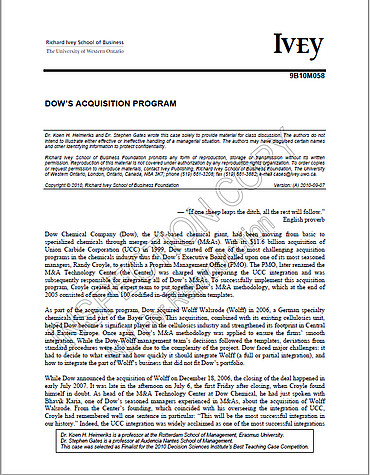Citation Note
Based on field research; 23 pages.
Follow the 'handle' link to access the Case Study on RePub.
For EUR staff members: the Teaching Note is available on request, you can contact us at rsm.nl/cdc/contact/
For external users: follow the link to purchase the Case Study and the Teaching Note.
Objective
Learning objectives: The case confronts students with the complexities and uncertainties of cross-border acquisition integration (e.g. speed, level of integration) and the way in which a renowned serial acquirer like Dow manages a medium-sized integration. Moreover, it underlines the pros and cons of M&A experience and the role deliberate learning mechanisms contained in Dow’s M&A methodology (the M&A Technology Center) play in improving the success rate of integrating acquisitions.
description
Dow Chemicals, a seasoned serial acquirer, succeeded in maintaining the unique qualities of a medium-sized target, Wolff Walsrode, by combining cost-efficiency with flexibility during the integration phase of the acquisition.
Abstract
This case illustrates how Dow Chemical acquired and integrated Wolff Walsrode, a German specialty chemicals firm that was part of the Bayer Group. This acquisition, combined with Dow's existing cellulosics unit, helped it create a new specialty business with a forecasted $1.1 billion in annual sales and strengthen its footprint in Central and Eastern Europe. The main challenge in this case concerns the complexities of acquisition integration, which were demanding in spite of Dow's extensive experience and track record. Dow was confronted with various integration challenges and faced several decisions concerning the degree and speed of integration of its target with one of its units, Probis. The decisions pit considerations of rapid cost synergy capture via leveraging global systems platforms against process technology transfer and accommodating different customers and their requirements. Along with providing a review of the importance of a multitude of codified implementation templates and tacit integration mechanisms, this case illustrates how Dow's M&A integration personnel proved their worth by ensuring Wolff's successful integration. The case challenges students with the complexities and uncertainties of cross-border acquisition integration (e.g., speed, level of integration) and the way in which a renowned serial acquirer like Dow manages a medium-sized integration. Moreover, it presents the inherent complexities involved in decision-making in the context of acquisition programs. Lastly, it underlines the pros and cons of the mergers and acquisition (M&A) experience, how to appropriately use M&A experience, and the role deliberate learning mechanisms contained in Dow's M&A methodology (the M&A Technology Center) play in improving the success rate of integrating acquisitions.
usage
The case offers unique insight into how corporate growth is realized through Dow's unique internal learning processes and how the learning is deployed in the case of Wolff Walsrode. Interesting for both academics and practitioners, this case demonstrates the tight linkage between practical relevance (what to do / not do as a manager when integrating a target) and theoretical understanding (organizational learning and dynamic capability studies).
